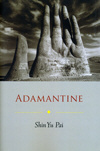Adamantine
Adamantine is not what it announces itself to be. By which, I mean adamantine (impenetrable as rock). Compact, solid, polished, focused in on itself, grounded as rock, yes. But, not stone-y or stone-faced, even as “Stone Face”:
In Yehlio, a jagged scar
runs across the neck
of Queen’s Head Rock,
a vandal’s foiled plot
to fence and ancient land-
mark on the art market
scarred stone hardly bears
her royal profile,
years from now to fall like
Franconia’s Great Stone
Face, the old Man
Collapsing, overnight
in a slip of rock
That overnight collapse, shatters the impenetrable, draws us into the image, sends me back to the poem’s opening. Where is Yehlio, I want to know now that there is an emotional payoff I so appreciate. It’s that subtle emotional payoff that keeps these poems, ultimately, from the adamantine, despite their sharp, granite persistence.
Shin Yu Pai is the author of seven previous books of poetry, including Haiku Not Bombs and the work in this volume does seem haiku-like in many ways, capturing a big idea in a small space and a small moment in a grand line; life composed as compact narratives, often through visually compelling images, appearing as if they had been conceived in one breath/glance, intact, viewed whole (unbroken like rock). They are grounded in place (a kitchen, a street, Yehlio, the crossing of Phanh Dinh Phung & Le Van Duyet, the National Palace Museum, Shentong’s Monastery, the Taiwan Strait, the Koh-e Bab Mountains, a Japanese garden, The Yellow River, a Museum, a roadside lumberyard, Chifeng); and in raw human emotion (here are just a few of Pai’s last lines: “in self-pity;” “the other crushing illusion;” “we lose;” “hammering out its heart;” “heart on one open hand”).
Techniques that might fail attempted by less skilled poets are wildly successful in Pai’s work, the repetition of the final three lines in one of my favorite poems in the book, “Burning Monk” (“his heart refusing to burn / his heart refusing to burn / his heart refusing to burn”) and italics for emphasis, used to great effect in “Hozho” (“into the intimate and the vast”); and reference to one of the best known and most quoted poems in American literature (“Thirteen Ways of Looking at a Vulture”): “eye / of the witness / the I of the commentator”).
Adept with shifting styles, tones, and preoccupations (an emotionally charged family memory; a sarcastic commentary on a social/cultural/political reality; a small metaphysical insight), the poet’s at her best, I think, when she is, after all, at her most adamantine, her stoniest (most solid, least overtly personal) as in “Bell(e)”:
in centuries
past, sunk
beneath soil
to draw earth’s
vital force, inert
vessel of
sound + light,
conserved
in a museum
of curative plants
the moment of
stillness &
gathering before
the shudder
of first sound
dreaming
the shake of chime,
hum &
gong
And in one of my favorite poems in the collection, “Greenhouse Effect”:
what makes the earth
suitable for life
cultivate enough
to feed a starving nation
I would argue that what makes the earth suitable for life, as much as food, is what this talented poet cultivates in Adamantine, the art of carving meaning out of stone.





